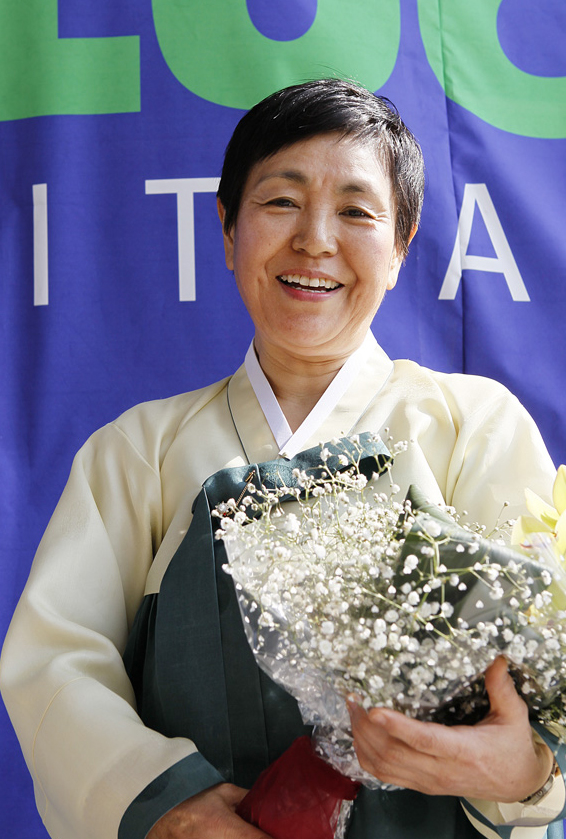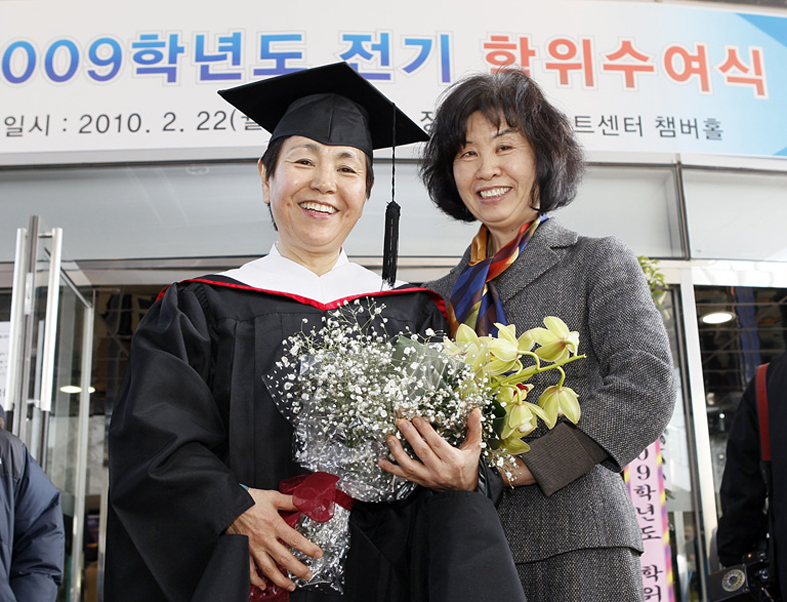An Older International Student in Search of the Roots of Japanese Culture Earns Master\'s in Korean History N
No.88344- Writer YU
- Date : 2010.05.27 19:06
- Views : 15770
Study on the \'Baekje King Shrine 百濟王神社’ in Osaka, Tracing the Baekje migrants forgotten in Korea
[Feb 23, 2010]
\"It was surprising to find that there was the trace of Korean culture in the shrines that are deemed to be the most Japanese among Japanese people while researching. There are still problems in the history between Korea and Japan, and I was happy to provide a stepping stone, however weak, for the proper research on history.\" 
A Japanese person, who came to Korea to trace the footsteps of the ancient kingdom of Baekje, which is being forgotten by Koreans, earned a master\'s in Korean history.
Okasa Wako (64, photo) earned her master\'s degree after completing her studies abroad, which she started at the age of 62, at the 59th graduation ceremony of Yeungnam University. She attended the ceremony wearing a hanbok that her guidance professor Kim, Jung-sook gave her as a present and showed her affection for Korea stating, \"When I first started studying ancient history in Korea, I was shocked how different things were interpreted between Korea and Japan. However, the further I studied I realized that the history of exchange between the two countries was very old, and that the two nations were very close. The Hallyu phenomena in Japan was no coincidence.\"
The title of her master\'s degree thesis was \'A Study on Baekje King Shrine\'. She was a teacher at an elementary school for 38 years in Osaka, and she always had a question on why the shrine that she frequently visited with her young students was still named \'Baekje King Shrine\'. The Baekje King Shrine is a shrine for King Gyeonbok, who was the grandson of King Uija, the last king of Baekje, and the shrine is in Hirakata city, Osaka until now. King Gyeongbok came to Japan in the mid 8th century and became the viceroy of this area for helping the Japanese emperor Sungmoo, who was the japanese emperor at that time.
Then, in 2000 when beginning interchange with elementary school teachers of Daegu, she became even more interested in Korean-Japanese relations and finally in March 2006, she retired as a teacher and came to Korea in November of the same year as a student. She started a new life after her sixty year life. At the time, her Korean skills was in infancy so she first started at the Yeungnam University Korean Language Institute. For 15 months she concentrated on studying Korean. At the same time, she prepared a study plan for entering graduate school and went to Professor Kim, Jung-sook of the Department of Korean History to explain why she wanted to enroll in graduate school. Finally, she passed Test of Proficiency in Korean and in March 2008, enrolled in Yeungnam University Graduate School of Korean History.
She then started to travel between Korea and Japan to begin her studies on the \'Baekje King Shrine\'. In order to answer her questions on why and how the Baekje King Shrine became worshipped by Japanese for over a millenium, she studied Japanese historical materials such as <Kojiki>, <Nihon Shoki> and <Shoku Nihongi>, and other historical records of the \'Baekje King Shrine\'.
In results, she found that the Baekje King Shrine became localized through the integration of the culture of royalty and Buddhism of Baekje with the folk religions of Japan, and claimed that it was historical evidence that the spiritual and cultural roots of Japan could be derived from Korea.

Together with Professor Kim, Jung-sook (right) of the Department of Korean History
She now plans to return to Japan and help her pregnant daughter, and she stated \"Korean parents sacrificed everything for their children and the children grew up and either took care of their parents or at least visited their parents frequently, showing that they had close relations unlike Japan. And I was envious of this.\" She added, \"I now plan to be a mother and grandmother, while continuing my studies.\"
Also, she stated \"I am very happy that I was able to study and earn a degree even after retiring,\" and added \"It was really difficult for me to translate my thesis into Korean after writing it in Japanese and I felt like giving up. But I was able to complete my course because of the help of Professor Kim, Jung-sook and a number of my fellow students.\"